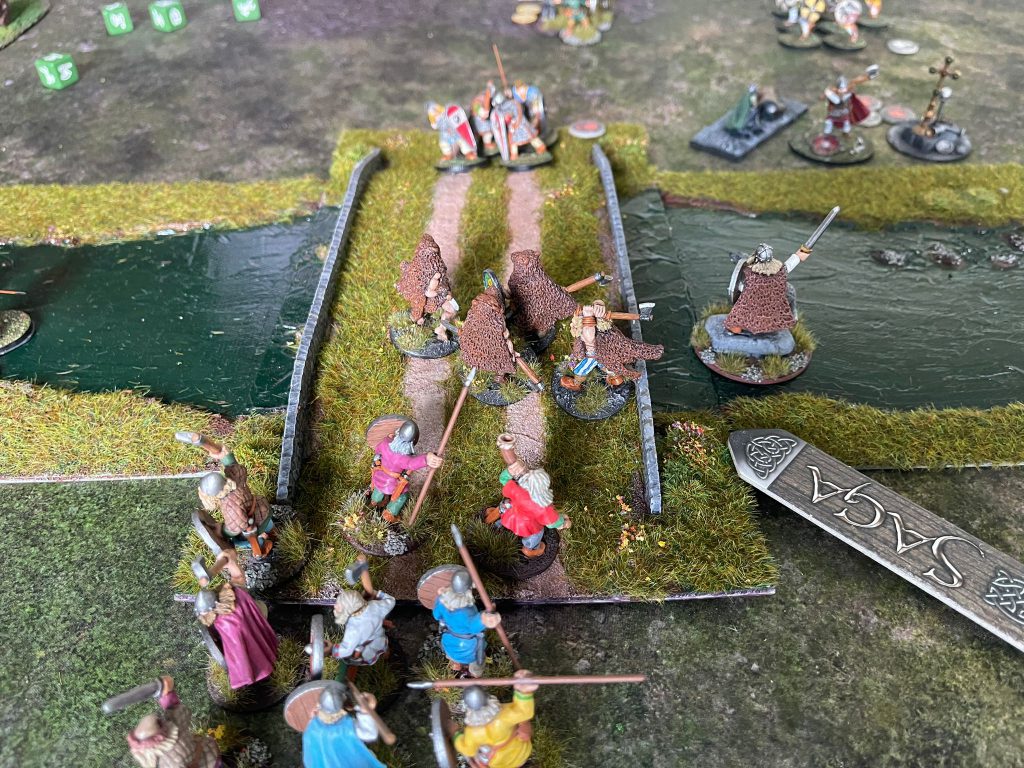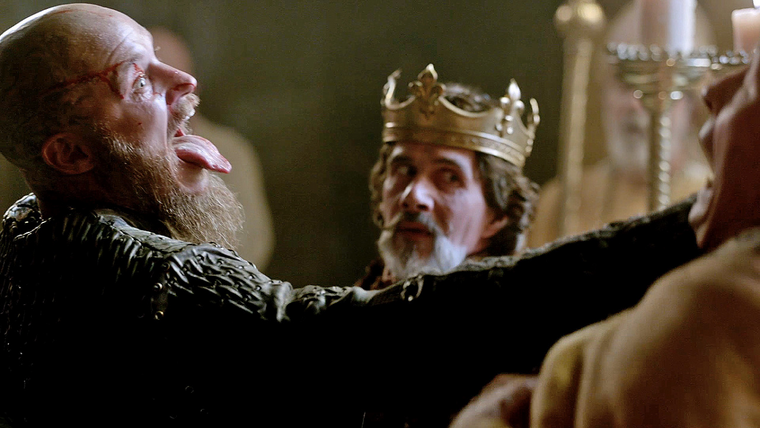Ravens. Shieldwalls. Pagans.
Age of Vikings is the foundational, formative SAGA book. If you’re reading this, chances are you’re interested in SAGA, and if you’re interested in SAGA, chances are you originally learned about it as ‘that Viking game’! This is the first book of SAGA 2nd edition published by Studio Tomahawk, and it’s by far the most popular, with most new players starting here.
Editors note: It’s SAGA Summer! Enjoy our coverage during the raiding season as we take a look at the factions, miniatures, and everything else you need to get started playing SAGA and earning massacre points.
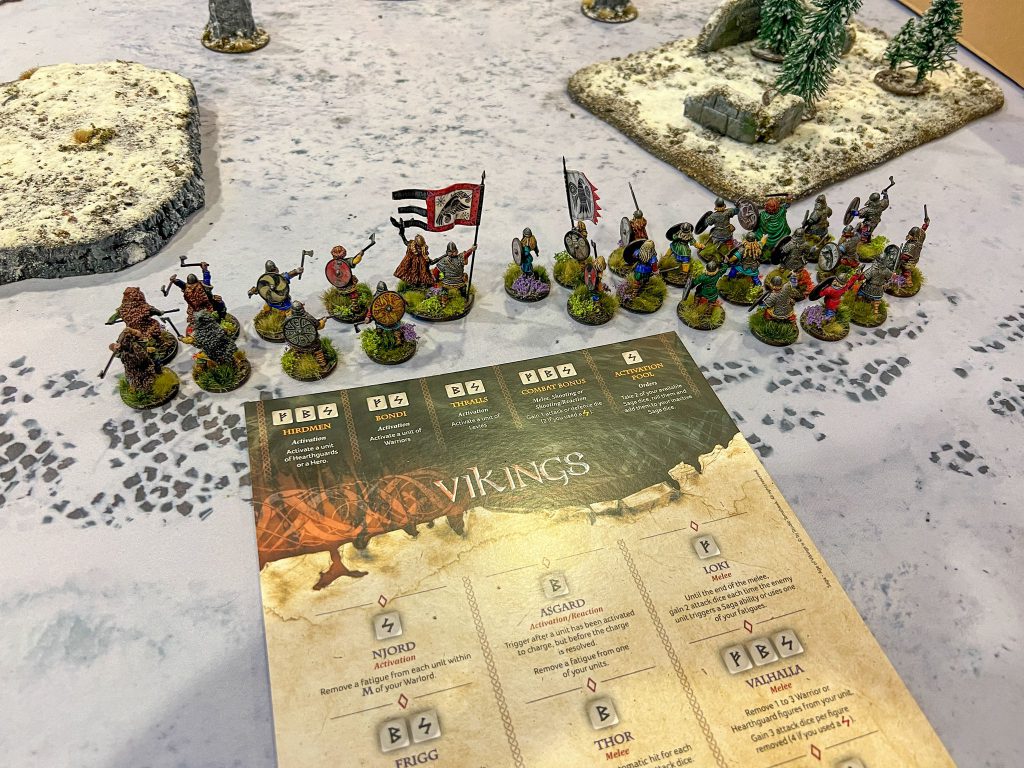
What’s in the Book
Being the first book, Age of Vikings introduces twelve factions to SAGA from all corners of Europe, each with a distinct battle board (read: faction rules and special abilities), unique wargear options for some, and powerful Legendary units for all. Legendaries, as the name suggests, represent iconic larger-than-life figures from history such as William the Conqueror or Ragnar Lothbrok, and they’re usually only usable with opponent permission as they often change how their faction plays. But you don’t need a Legendary unit to get a good taste of a faction; each has distinct rules giving them a bit of unique flavour.
The book also includes fun, optional rules for Relics and Artefacts, allowing your Warlords to pick up Christian or Pagan relics from bygone ages, as well as powerful heirlooms and weapons evoking the magic (some would say cursed) weapons of the Icelandic sagas. Additionally, Age of Vikings started the ‘Old Friends, New Enemies’ section in SAGA books, which is basically a way to use models from another SAGA Age in a new book; the Steppe Peoples, Umayyads, Germanic Peoples and Lombards are new to Age of Vikings, each of which allow you to use models and rules from Age of Invasions and Age of Crusades.*
There are also rules for War Banners – the mighty battle standard of your warband, of which you can take only one – granting fatigue-recovery bonuses to the unit carrying it; andrules for Mercenaries, ranging from Shieldmaidens, to Steppe Nomads, to Egil Skalagrimson himself – but those are worthy of another article at a later date as there’s so much to say about them!

*although we note that mixing Ages works just fine game-wise – it may not always be what you’re after, but “Age of Melee” tends to be an accepted format for playing the game and is a great way to ensure everyone can play together!
As for the Age of Vikings factions proper, here we go – let the deep dive begin!
Vikings
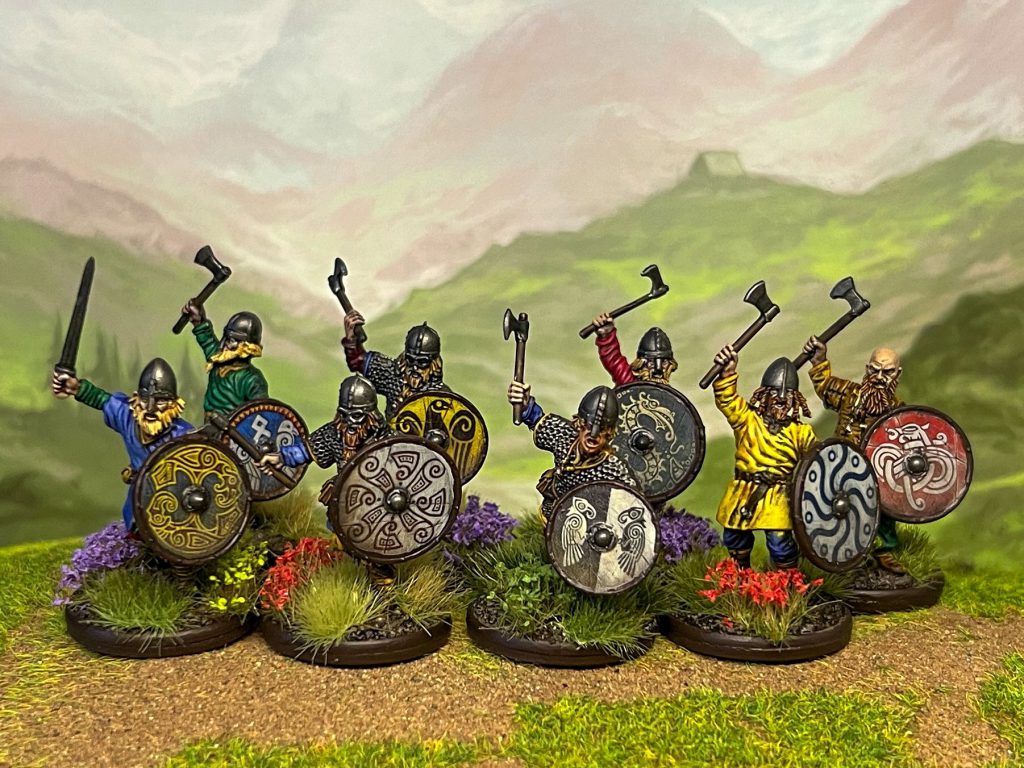
- Who they are: The Vikings are the eponymous faction of this book, representing the Norse, Danish, Swedish and Icelandic raiders, traders and explorers of the titular Viking Age. Chances are if you meet a SAGA player they have a Viking warband (or figures that could be used easily as Vikings). They’re the starter faction, with all that that entails; fairly straightforward gameplay, with a focus on getting up close and personal in melee.
- What they’re good at: As befits a beginner faction, Vikings are overwhelmingly melee-focused, and tend to be built around lots and lots of Warriors with a few Hearthguard and a unit of Levy thrown in. Their playstyle revolves around fearlessly throwing yourself at the foe, heedless of the risk (sometimes even sacrificing your own models with the Valhalla ability to generate additional attacks). That means that they’re good at killing things, but they die pretty fast themselves. Canny players will note that there are a few abilities on the board – particularly Njord, Frigg and Asgard – which are there to mitigate the Fatigue you build up, and your world-ending Ragnarok ability makes all your charge activations free for a single turn. Timed right, a Viking army can mount a really fearsome attack, although the casualties will be high on both sides..

Viking Berserkers seize the bridge… (Credit – James T, London SAGA Mead Hall) - What’s special about them: Berserkers! One point of Viking Hearthguard can be replaced (no cost) with a single point of Berserkers. These are more lightly-armoured Hearthguard with a whopping 4 attacks per model. They’ll hit incredibly hard – but they’ll die to a stiff breeze. Once a pack of Berserkers is on the table, someone’s guaranteed to go to Valhalla – them, or their enemies.
Anglo-Saxons
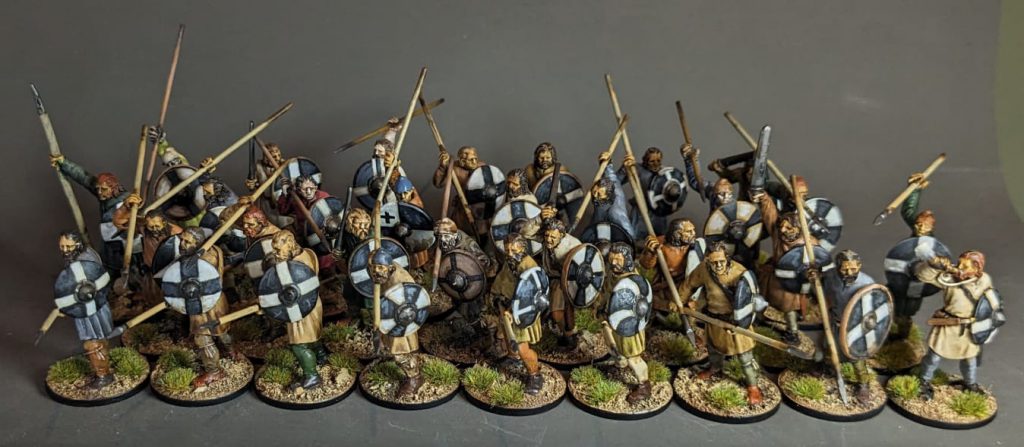
- Who they are: The Anglo-Saxons roughly represent the kingdoms of East Anglia, Mercia, Wessex and Northumbria – essentially, modern-day England – in the 6th-9th centuries AD. They’re distinct to the later Anglo-Danish kings, of whom Harold Godwinson was one; Alfred the Great is the most famous Anglo-Saxon king of this period, although others include Aelle of Northumbria and the harshly-named Aethelred Unraed (‘the Unready’).
- What they’re good at: Anglo-Saxons are the polar opposite of the Vikings. Whereas the Vikings are warrior-focussed and all about attacking, the Anglo-Saxons are built around the fyrd, the peasant levy called up to defend the Anglo-Saxon kingdoms in times of need. Anglo-Saxon warbands are really defensive, with plenty of abilities improving the survivability of their Levies and units over ten models. If you’re looking for the warband that can castle up and weather a storm – even at the expense of mobility – Anglo-Saxons are the one for you.

Average interaction between Viking and Anglo-Saxon players. (Credit: Vikings TV show, History/Amazon Prime) - What’s special about them: Not their warband options, but their battle board overwhelmingly pushes Anglo-Saxons toward a Levy-heavy list. This can be taken to extremes (some players go for 6pts of Levy – a whopping 72 figures), which makes them one of the largest warbands in SAGA. Not for the faint hearted!
Normans
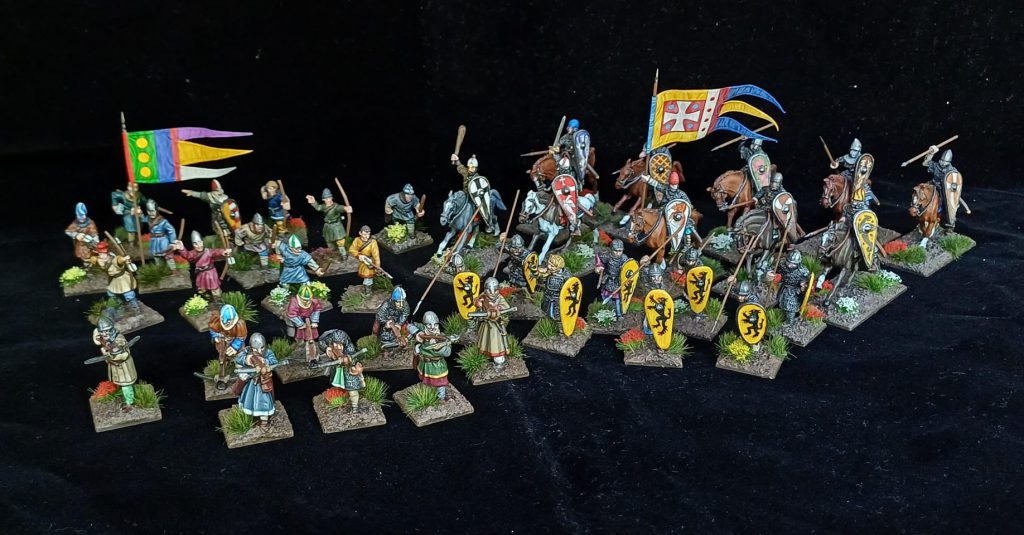
- Who they are: The warband of William the Conqueror, the Normans represent the inhabitants of Normandy during the 11th century. In practice, these aren’t just the guys who conquered England during the Norman Conquest; they’re also a faction that covers the 11th century Bretons, and the Siculo-Normans, the Italian descendants of the first Normans to travel to Italy in the late 11th century.
- What they’re good at: Speed. The Normans can be lightning fast. They’re easily the most manoeuverable faction in Age of Vikings, with a pair of great Activation/Reaction abilities which let them move mounted units during their opponent’s turn. This doesn’t mean that they cover the most ground – that’s the Carolingians, more on them later – but it does mean that Norman players have incredible flexibility during their opponent’s turn, being able to reposition all their mounted units in response to a single enemy unit activating. Also – the Normans hit hard on the charge! Mounted units can really pack a punch (particularly against infantry), and if you’re bringing archer Levy, you have the only ability in the game that lets your bowmen fire at twice the usual range…
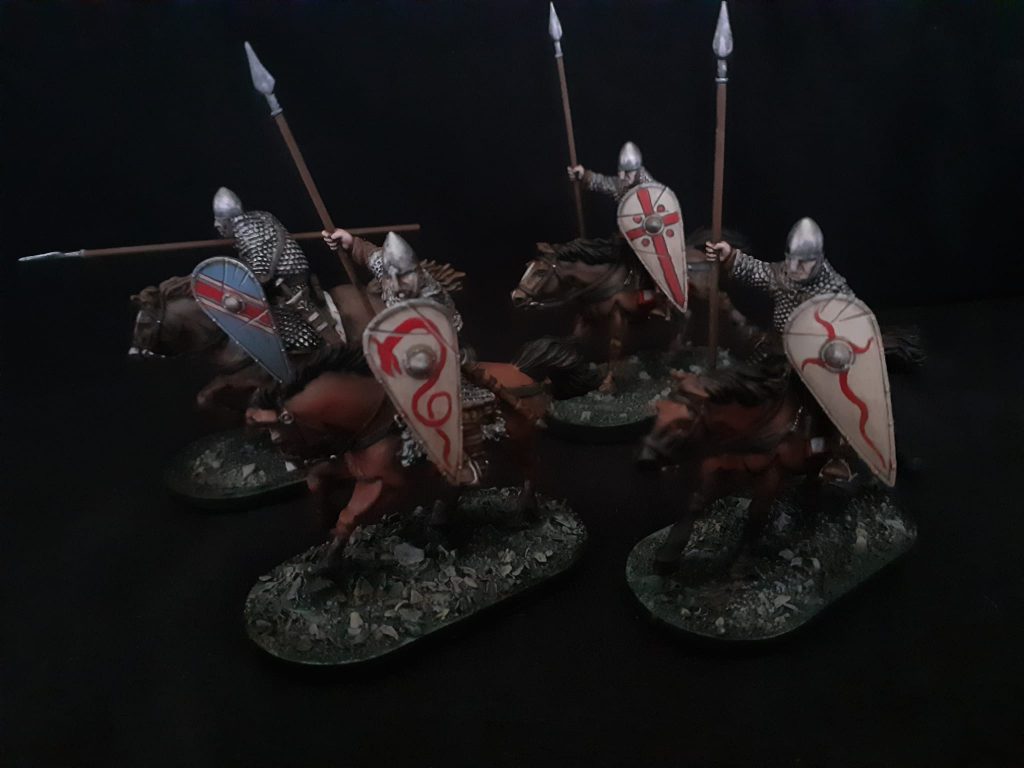
- What makes them special: You’ll have gathered by now the Normans are fast – that makes them stand out a bit in Age of Vikings, where most factions are mostly on foot. The only other factions to really go as heavily mounted as Normans are the Carolingians and Welsh. This means the Normans can rely on being faster than most factions, but like other cavalry-heavy warbands, they need to be careful about terrain, which can really limit horses’ movement.
Irish
- Who they are: They need no introduction – the inhabitants of Ireland during the Viking Age, right up into the 10th and 11th centuries, who bitterly resisted the Norse invasions of Ireland in the 8th and 9th centuries.
- What they’re good at: The Irish are a really interesting faction. They’re basically the ‘guerilla warfare’ faction in Age of Vikings; most of their abilities have something to do with shooting or using terrain to your advantage, blocking the enemy from attacking a unit in terrain or even popping out of terrain behind enemy lines to throw javelins at the enemy! You aren’t looking for massed infantry charges or fighting in the open fields; you’re looking at a faction that will mercilessly whittle down the enemy from the cover of dense terrain, with a couple of abilities making Irish heroes among the most powerful in the game.
- What’s special about them: The Irish can take two unique units: Wolfhounds, who function as Warriors with double the usual charge range (and are unaffected by uneven terrain), and Curaidh, ‘warrior heroes’. These guys are like mini-Warlords who can put out tons of hurt and benefit from the two Hero-centric abilities (Blood of Kings and Ireland’s Heart). Taken together, both are interesting options; Curaidh can hit like hammers, and Wolfhounds are great for flushing the enemy out of terrain (and also chasing down enemy cavalry).
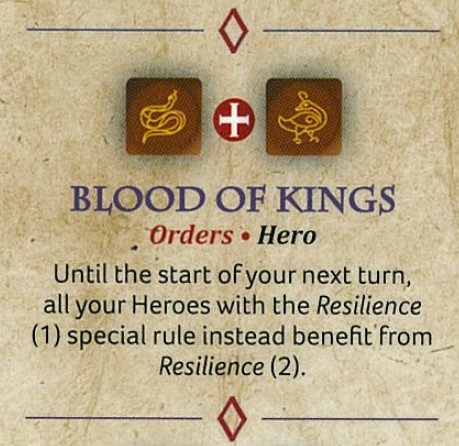
Scots

- Who they are: Denizens of the vast northern reaches of the British Isles left unconquered by the Romans, the Scots in SAGA represent the early stages in Scottish unification under Angus Mac Fergus up until Malcolm Canmore swore allegiance to William the Conqueror in the 11th century.
- What they’re good at: The Scots are a ‘finesse’ faction. They have a reputation among a lot of players for being really defensive, with powerful abilities granting them bonuses to defence; but the truth is the Scots can also hit really hard on the attack, with a couple abilities also granting them decent shooting. They’re the first of the Age of Vikings factions in this article who really benefit from an important concept in SAGA: sequencing. The order you trigger abilities on the Scots board can be really important, with abilities like Stand Together allowing you to charge with a unit and then count as the defender in the ensuing melee – opening up a whole host of abilities you’d normally only use in the opponent’s turn.
- What makes them special: As the above suggests, the Scots really require a player to master the order you trigger SAGA abilities, as well as how to combine them. The Scots can generate SAGA dice during their opponents’ turn, which is a rare ability in SAGA (see the No Respite ability); this can make the Scots really hard to predict, as you’ll be able to place dice on your battle board during your enemy’s turn to counter their strategies!
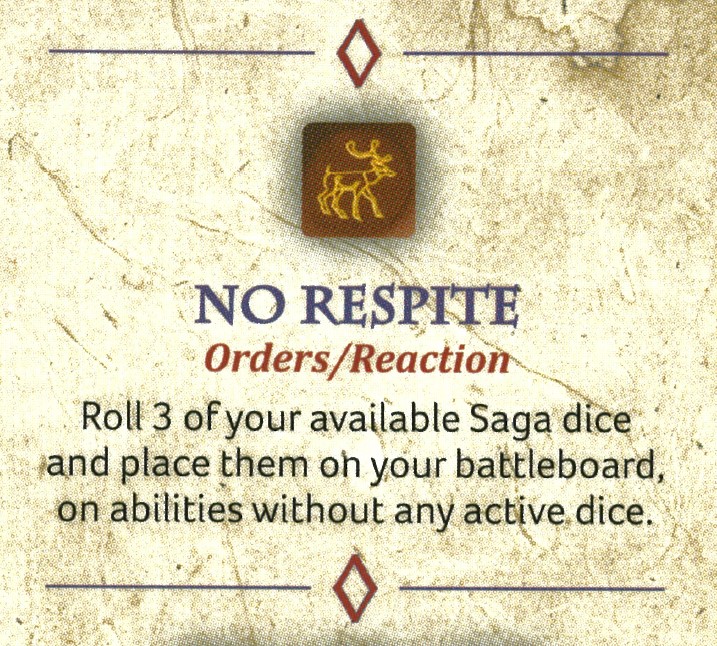
Welsh
- Who they are: The original Briton inhabitants of the British Isles, the Welsh have had a hard time of it; facing invasions from Rome and then the Germanic peoples (the Angles, Saxons, Jutes and others), the Welsh stubbornly refused to yield, and remained a thorn in the side of the English (and then Norman) kings long past the Viking Age. The Welsh in SAGA also represent the Kingdom of Strathclyde, the Brittonic kingdom encompassing southern Scotland and parts of north-west England (and modern Wales).
- What they’re good at: The Welsh are another interesting faction. Like the Irish, the Welsh can really benefit from terrain, with their Children of the Land ability allowing all your infantry to move through terrain unimpeded. Like the Normans, they also have several Activation/Reaction abilities allowing you to not just move, but also shoot and charge. If your opponent hasn’t planned ahead, this means the Welsh can be a nightmare to face; a player activating to charge a Welsh unit might find his men get shot to pieces (or charged themselves) before they’ve even moved. The Welsh are fast, nimble and very hard to pin down!

- What’s special about them: The Welsh sub-faction, Strathclyde, is fully mounted. In theory, this can mean that a Welsh army can outmanoeuver a Norman army; making the Welsh one of the most nimble factions in Age of Vikings. Additionally, the fact that the Welsh don’t have to be fully mounted means you can decide which units are mounted and which are on foot at the point of deployment, making the Welsh very adaptable to the situation at hand.
Last Romans
- Who they are: The name would probably suggest that these guys are the last Romans left behind in Britain when the Empire receded, but actually, these guys are mostly meant to represent the Eastern Roman Empire (soon to be known as the Byzantine Empire).
- What they’re good at: Precisely what you’d expect from the early Byzantines, these guys are early proponents of combined arms tactics built around the standing army of Constantinople, the Tagmata. Heavily armed kataphraktoi (mounted Hearthguard) provide the killer punch in the army, whilst your Warriors and Levy provide combined melee defence and missile fire. A Last Roman army tends to be very shooty, and very reliant on large units of Warriors, with abilities like Protect and Defence allowing you to redirect enemy charges and shooting attacks. Being able to shoot with a unit of Warriors using Indirect Fire to shoot over intervening terrain or units means the opponent is never safe!
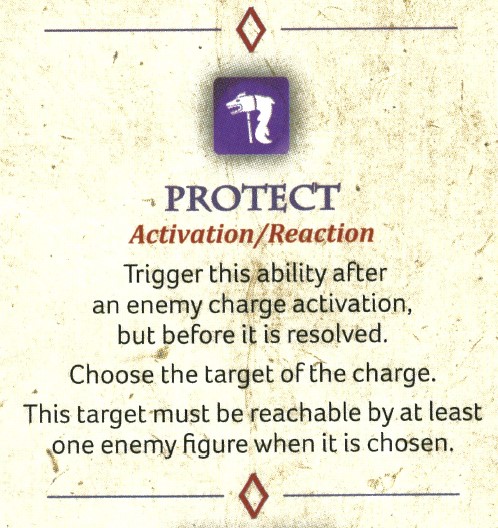
- What makes them special: The Last Romans don’t really do anything wildly unusual, it’s more that they do everything reasonably well. They’re a slightly ‘finesse’ faction like the Scots in that there aren’t really any uber-abilities on their board, but they can get a decent amount of mileage from an experienced general.
Jomsvikings
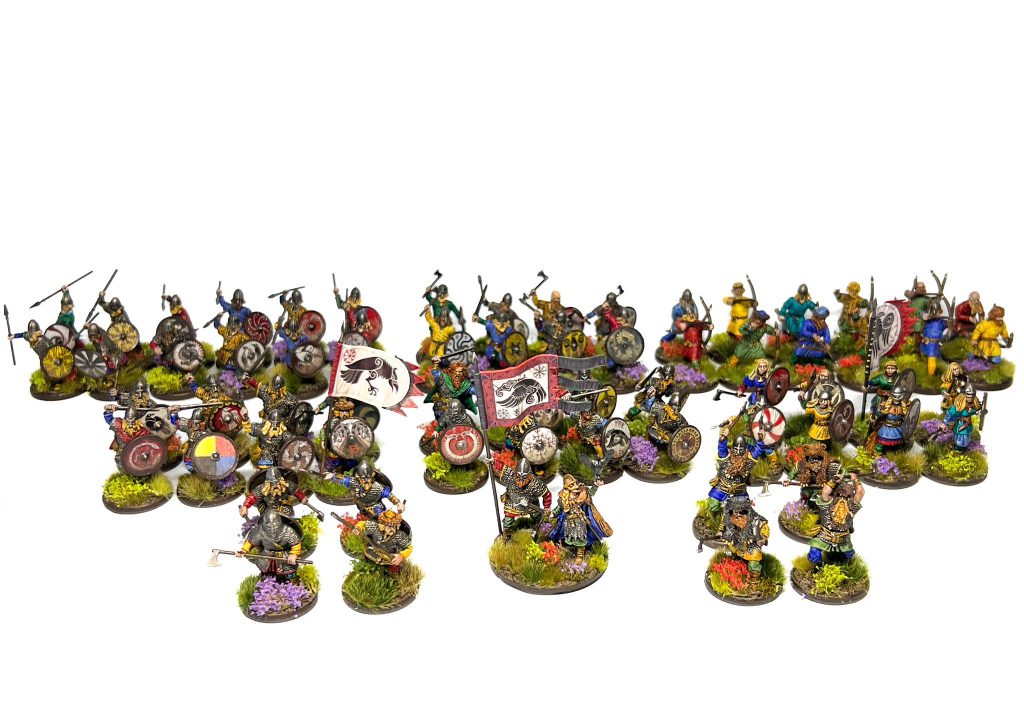
- Who they are: A brotherhood of mercenary Vikings now believed to be semi-legendary, operating out of the fortress of Jomsborg off the southern Baltic Sea, the Jomsvikings were also believed to be staunch adherents to the Old Norse faith even after most Scandinavian countries underwent Christianisation.
- What they’re good at: If the Vikings are rabid, bloodthirsty hounds, Jomsvikings are older, battle-hardened wolves. They’re just as deadly as their younger, fiercer counterparts, but in a more measured way, with most of their abilities more balanced across attacking, defending and shooting. They have semi-mythological abilities (being able to invoke lightning strikes on the enemy, and possibly even Mjolnir itself), a trope they share with the Pagan Rus later on. Some would say the Jomsvikings are a stronger faction outright than the Vikings; the author would suggest that the Jomsvikings can be a really powerful faction, but they take a bit of cunning to use properly.
- What makes them special: Yes. Jomsvikings have Wrath tokens, which is the central conceit of the board. Almost every ability you trigger, your opponent can cancel, at the cost of granting you a number of Wrath tokens. Sounds harsh? Not really. Once you have enough Wrath tokens, you can start to trigger REALLY powerful abilities that your opponent can’t cancel and turn your units into (almost literal) gods of war. As befits a wolf on the hunt, this means the Jomsvikings are masters of mind games. Does your opponent let you activate that unit now, or do they cancel the ability – knowing full well they might be sealing their own doom by increasing your Wrath…?
Carolingians
- Who they are: As the name suggests, these are the warriors of the Frankish empire on mainland Europe during the 8th-10th centuries, the heirs to the legacy of Charlemagne himself. The faction also includes equipment options representing the post-Carolingian Capetians and the pre-Carolingian Merovingians.
- What they’re good at: Carolingians are an odd faction in SAGA. They’re good at a lot of things; their central strength comes from an ability called Ardor, which lets you activate multiple units to move or shoot without generating Fatigue. In practice, this means Carolingians can activate a lot of units a lot of times during one turn. If you’re fielding a bow-heavy, or cavalry-heavy force, this means you’re either very, very fast or very, very shooty. Or both! They’re not bad in melee either, but their melee abilities mostly work for shooting as well, meaning that Carolingians can be really oppressive when fielding a lot of archers.
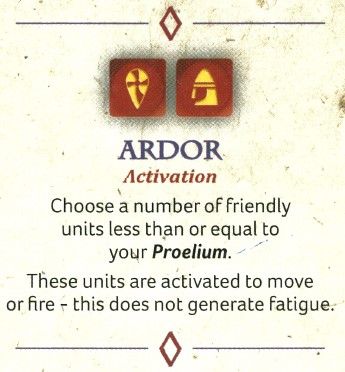
- What’s special about them: The Proelium tracker replaces the ‘Activation Pool’ ability. In practice, you fill up Proelium with up to 3 SAGA dice, each of which has to show a different facing. The amount of Proelium you have determines how powerful some of your abilities are; you’ll want to have max Proelium all the time!
Norse-Gaels

- Who they are: The Norse-Gaels, or Hiberno-Norse, were a people of mixed Gaelic and Norse ancestry coming from the kingdoms the Vikings established in Ireland, notably the Kingdom of Dublin.
- What they’re good at: In keeping with their Viking heritage, the Norse-Gaels are absolutely ferocious in melee. Whilst their Warriors and Levies have some ranged ability with their javelins (and a canny Norse-Gael warlord will take advantage of this), the Norse-Gaels want to get into melee – and stay there until their foes are crushed.
- What’s unusual about them: The Norse-Gael abilities all interact with the Combat Bonus basic ability on the battle board in interesting ways, either augmenting it (meaning you gain more dice when you trigger it) or filling it up very, very fast. Either way – you’ll be triggering your Combat Bonus a lot!
Pagan Rus
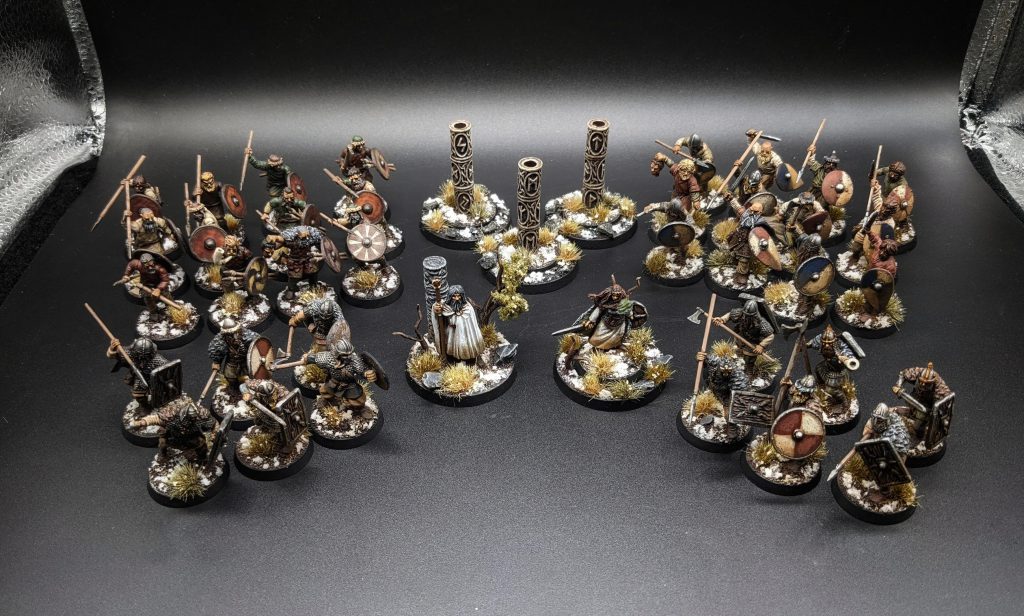
- Who they are: The name itself conjures images of the freezing East. The Pagan Rus represent, largely, the Kyivan Rus, the Rurikid dynasty, the pagan antecedents to the later Rus Principates and inheritors to East Slavic, Norse and Finnic bloodlines.
- What they’re good at: Cunning and ferocious in equal measure, the Pagan Rus take some of the Viking and Jomsviking traits and blend them with their own unique heritage. They’re a battle board that is all about disrupting the opponent, slowing them down and withering their units with blasting winds straight from the steppes. They pack a hell of a punch in melee, but their real strength is in utterly exhausting the enemy before they’ve even come to blows – sometimes preventing them from activating at all.

- What’s special about them: The Rus rival the Jomsvikings for mind games. The aptly named Wrath of the East ability grants all your units 2 attack and 2 defence dice every time their armour changes during a melee (yes, whether caused by you or your opponent!), and this chains with abilities like Blood Feud and White Wolves to grant truly astonishing numbers of attack and defence dice. But before you’ve reached melee, your mastery of the freezing cold weather of the East – particularly The Long Winter, Frozen Wind and Biting Cold – can wreak total havoc on an enemy army, especially a mounted one. Pagan Rus can be one of the most rewarding armies to play in the game, or the most frustrating to fight against; it’s only fitting they have a steep learning curve!
Anglo-Danes
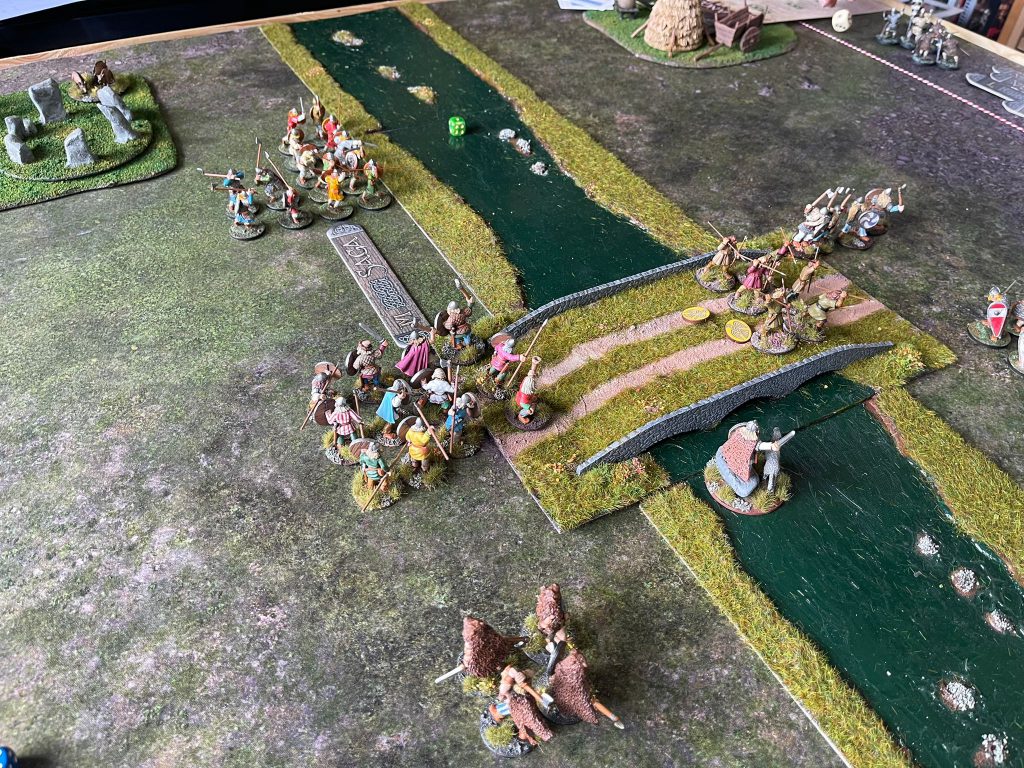
- Who they are: The successors to the Anglo-Saxon kings, the Anglo-Danes represent the Danish kings of England such as Cnut the Great all the way up to Harold Godwinson himself, of Hastings fame.
- What they’re good at: Pretty much as you’d anticipate, the Anglo-Danes mix Saxon and Viking traits. They’re a faction who can generate additional SAGA dice rapidly through Noble Lineage, whilst hitting really hard with their dane-axes and benefiting from the shieldwalls popularised by their Saxon forebears. They are very strong defensively, but not to the same extent as the Anglo-Saxons; equally, they can hit much harder, although not as hard as the Vikings.
- What’s special about them: The Anglo-Dane blended playstyle can be a tricky one to master, but they’ve got a lot of nuance under the hood. Their ability to inflict extra fatigue on the enemy really shouldn’t be underestimated; they’re a faction that benefits from planning ahead, as they can spend a turn or two dishing out fatigue strategically across key units in the opponent’s force, before charging in (probably with Shock, denying the enemy the chance to close ranks), dropping their armour below 4 and then triggering the aptly named Crush the Weak to supercharge your attack dice.
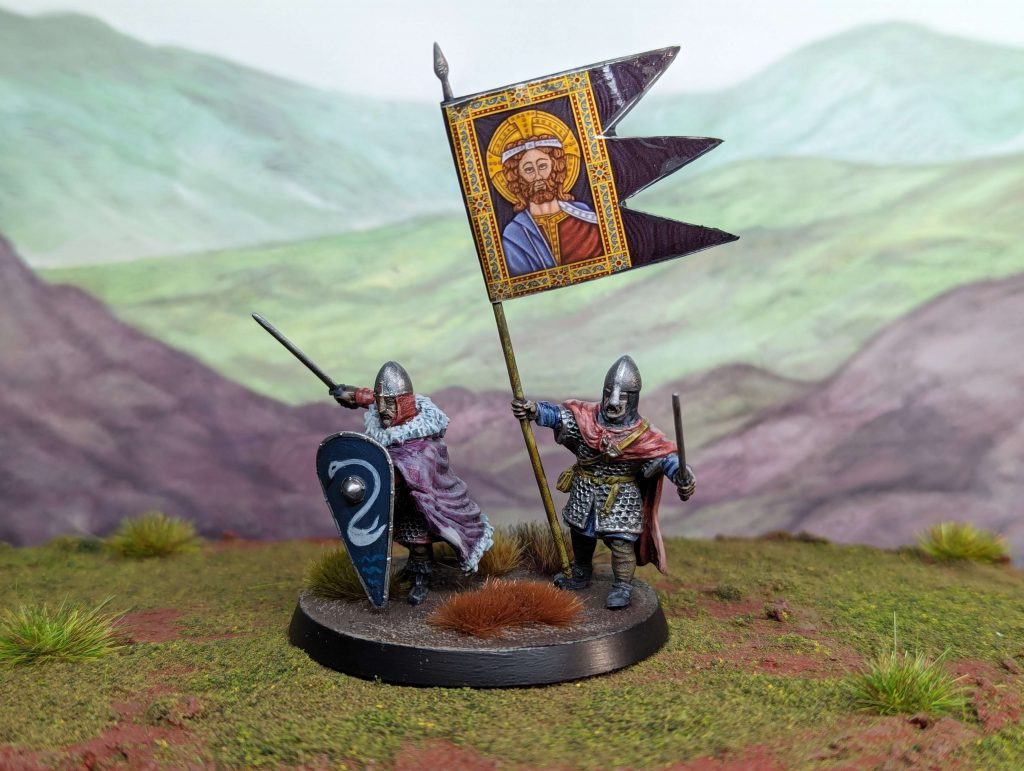
And that’s it – Age of Vikings in a (not so) nutshell! There’s a lot more to dig into on each faction, so we might go into more detail on specific factions at a later date, but for now that’s enough to get started. Which faction piqued your interest the most?
Have any questions or feedback? Drop us a note in the comments below or email us at contact@goonhammer.com. Want articles like this linked in your inbox every Monday morning? Sign up for our newsletter. And don’t forget that you can support us on Patreon for backer rewards like early video content, Administratum access, an ad-free experience on our website and more.

